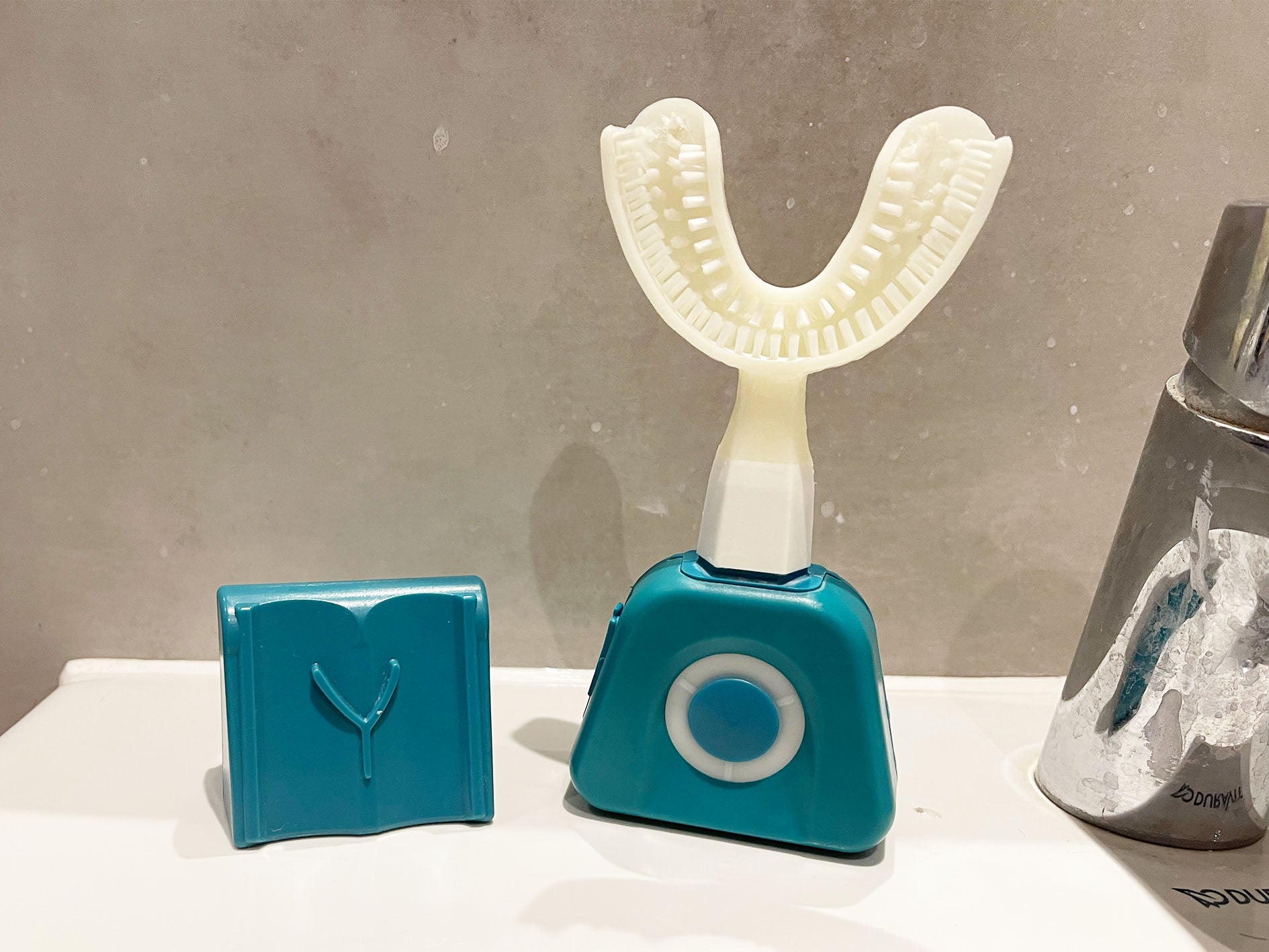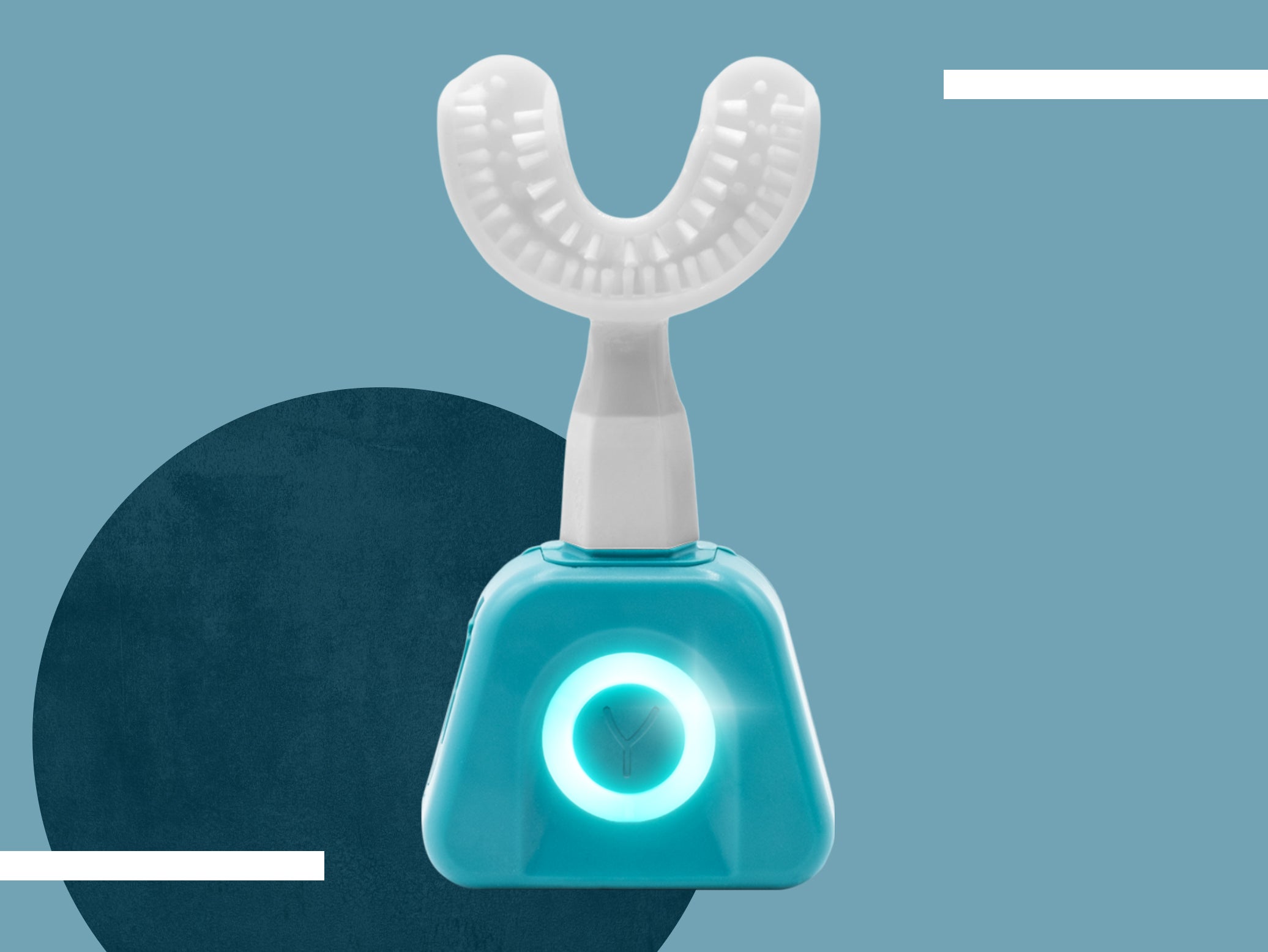Y-Brush nylonmed V2 toothbrush pack

Buy now £108.99, Y-brush.com
- Cleaning modes: Three
- Included accessories: 1 handle with integrated battery, 1 brush, 1 USB cable, 1 toothpaste applicator
- Power source: Battery powered
- Battery life: Three months
- Rating: 7/10
Design
There’s a reason why FasTeesH recommends we take two weeks to try this thing out, and that became evident when I unboxed the toothbrush head and unpacked the stand. This thing is weird, and it’s unlike any other toothbrush I’ve tried before.
Some toothbrushes have rounded, oscillating heads, some are diamond-shaped and some are made for interdental brushing. The Y-Brush is none of these, and you need to re-learn how to brush your teeth.
It’s basically a sports mouthguard with nylon bristles – 35,000 to be exact – lining the inside and positioned in such a way where it can clean all three surfaces of your teeth. The mouthguard attaches to a hard plastic trapezoid-like handle, which houses the motor. So true, it’s not the best-looking toothbrush appliance in the world, but if it gets the job done, I’d be happy.
Read more: 9 best electric toothbrushes that keep teeth healthy, bright and pearly white
There’s a large and very hard button on the front of the holder, which is used to turn on the brush and adjust the power. This is surrounded by a ring of LED lights, helping you identify the brush intensity, and the amount of charge the toothbrush has left when plugged in. The button isn’t massively intuitive, however, and really could have done with some fine-tuning.
It’s really tricky to know when a button press has been registered because it requires an extremely hard press, so you can’t tell if you’ve pressed it hard enough to turn it on unless you’re looking at the ring of lights. Soft pushes won’t register at all.
It’s also a little confusing to operate. You have to hold down the button to turn it on at its previous power setting state, hold it down again if you want to change that power setting, then press it once shortly to get it going. But you have to make sure it’s not a hard hold down or you’ll end up in a death loop, cycling through the power settings over and over again, trying to get back to the one you wanted.
This becomes even more of a pain when you realise you have to hold the toothbrush horizontally up in front of you with both hands. With most standard electric toothbrushes, you pop the thing into your mouth, press the button and it starts vibrating instantly. This needs a lot more pressing and guessing. A series of power setting buttons might have been a better, less cumbersome design choice.
Read more: We tried Waterpik’s ultra plus WP-150 water flosser
The Y-Brush also comes with a rubber applicator for kids and adults, which looks like a little helmet that you pull over the toothpaste nozzle and then squeeze to fill the mouthpiece tray with a paste of your choice. The brush itself comes in two different sizes – small (for kids under 12) or medium (for anyone over the age of 12).
Did it change our life?
While the design is a little, well, unrefined, the magic really happens when you actually start brushing. There are three different power modes – soft (15 seconds), normal (10 seconds) and intense (5 seconds).
To brush your teeth, you select a vibration mode, hold the Y-Brush in front of your face, slide the mouthguard around the upper row of teeth and rotate the head left to right while chewing down into the bristles. Once it stops vibrating, switch to the bottom row and go again, performing the same rotational motion while chewing down. What this supposedly does is clean all around the tooth and up toward the gum line. It’s honestly a very strange sensation, but thankfully doesn’t last very long – especially if you’re using the five second mode.
Read more: Can the Colgate’s E1 smart toothbrush help you brush up on your cleaning technique?
During the first few days, it didn’t feel like my teeth were actually being cleaned. That fresh feeling you get after a good ol’ brush was missing. But once I’d played with the angle in which I held the toothbrush in my mouth, how intensely I chewed and my choice of vibration level, it started to feel like the Y-Brush was finally brushing better.
Although after two weeks, I still don’t think it brushed up into the gum line quite effectively enough. Y-Brush recommends chewing even more to get up into that gum line. Perhaps what was even stranger was that it felt like my teeth were cleaner when I used the intense five-second mode over the slower 15-second vibration speed. Not to mention that it became increasingly difficult to hold back the gag reflex when brushing the upper row of teeth for 15 seconds.
On top of all this, there was one big issue, and it threw the whole concept of a 10-second toothbrush out the window. My brushing routine took a whole lot longer than 10 seconds.
It’s a faff, to put it mildly. Firstly, it takes longer to apply the toothpaste all the way around the mouthguard using an applicator than it does to dollop a little onto the end of a typical brush head. And there’s no way to clean your tongue, so I ended up switching back to my old toothbrush anyway to finish the whole thing off, adding even more time to the routine. You end up doing more things to clean your teeth that it almost makes the whole process a little redundant.
Read more: 8 best toothpastes for every concern from whitening to treating sensitivity
That said, Y-Brush does sell toothpaste tablets, which might have cut down the amount of time needed to applicate the mouthpiece evenly because, I assume, you’d just have to pop a tablet in your mouth before you start brushing, rather than squeezing toothpaste methodically through a U-shaped bend.
There are indeed times when I find it more convenient to pick up the Y-Brush than my usual electric one, though, and that’s for post-meal brushes when I wanted a little mid-afternoon dental clean, or – let’s face it – when I was in a rush to get out of the house. The Y-Brush cleans just about as well as an electric toothbrush, so I didn’t feel like I was skimping out on a good, hearty teeth-cleaning, prior to dashing out of the door.
Does the Y-Brush really work?
The big question though, is: does it really work? Will your teeth be just as clean using the Y-Brush compared to using a manual or electric toothbrush? And therein may lie the hitch.
“It’s a great concept, but it just needs to be put into a really good scientific trial,” says Damien Walmsley, professor of restorative dentistry at the University of Birmingham and a spokesperson for the British Dental Association. “It's a bit like charcoal toothpaste. You can put these things out and the concept sounds really good, but it takes a long time for the evidence to catch up with it.”
Read more: 9 best teeth whitening kits for brightening your smile at home
You can’t really calculate how effective a toothbrush is with just one reviewer’s anecdotal experience. You need some serious data to back it up. According to Y-Brush, numerous studies have been undertaken to prove its efficacy, although links to the studies haven’t been provided and we can’t see any published research.
One of the few pieces of accessible research seems to be a small-scale study from 2020 in the International Journal of Environmental Research and Public Health, which showed that a U-shaped brush with silicone bristles wasn’t effective at removing dental plaque. Y-Brush differs in this instance, however, and a spokesperson for the company said: “Y-Brush is not made of silicone bristles but of nylon bristles as found in conventional manual and electric toothbrushes.”
That’s kind of been the pass and parcel for all research into toothbrush tech for a long time. We didn’t see a full and complete review of the data into the effectiveness of electric toothbrushes over manual ones until 2014 when the reputable Cochrane Library published its findings. “We know that the electric toothbrush is scientifically proven to work,” says Walmsley. “But this just needs to go through the same testing process and, until then, the jury will be out.”
The verdict: Y-Brush nylonmed V2 toothbrush pack
The Y-Brush is a new style of toothbrush promising to cut down your brushing time to just 10 seconds. It looks a bit weird, has a few design quirks and takes a bit of time to get used to, but it really does show promise. While you can technically brush your teeth in just 10 seconds, there are still other factors to consider – like the length of time it takes to apply the toothpaste and the fact that you can’t brush your tongue – making it more like a minute of brushing.
I think that the Y-Brush still has a few more iterations to go before you’re able to ditch your current electric toothbrush, especially since it costs roughly £108.40 in the UK – a similar price to the current crop. But with the company announcing a new Y-Brush concept at CES earlier this year, featuring an improved design, six cleaning modes, Bluetooth support, and importantly, a better way of brushing that only requires the user to swivel it from left to right (no chewing down necessary), the toothbrush of my dreams might be here sooner than we think.

